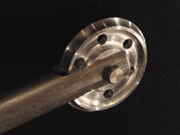
We have extended the offer to our readers on numerous occasions to send in their ideas and possibly a new invention or two. Before you nominate us for sainthood for being magnanimous, please consider that our true motives are purely selfish. We would like nothing more than to be the vehicle of the next life-changing invention. Our true dream is of fame and fortune. We giddily imagine ourselves driving obscenely priced cars to movie premiers, wearing Armani suits, drinking Dom and ... sorry. For a second there we forgot we write for W&C, not Rolling Stone.
Little caesars
Back to the real world now. One of our readers took us up on the invite. Steven Henits, owner of Fords Drywall, some time ago sent us a very novel tool and an idea that is beautiful in its simplicity. He calls it the ButtTaper. While not wanting to minimize past articles in this fine magazine on the options you all have in the finishing of butt joints, we feel this new approach will be embraced universally.When we first opened our packages from Steve, the thought that first struck us was, "This is the biggest pizza cutter we have ever seen." Upon further review, we were struck by the simplicity of the concept. The very idea of creating a bevel in the butt joint allowing it to be finished with a minimal amount of effort, mud and expense was exhilarating.
The basic concept is to bevel the edges of adjoining butt seams. This achieves two things. First, one major problem encountered in the finishing of butt joints is ridging. This occurs when the raw edges of the gypsum separate from the face paper. As we all know, this phenomenon occurs only after the final coat of paint goes on the wall, leaving the builder, painter and homeowner all pointing accusatory fingers in your direction. This tool will make ridging (and bruises from bony fingers) a thing of the past. By beveling the joint, the face paper is actually crimped inward making it impossible for it to lift.
The second obvious advantage is being able to finish the joint very flat with a minimal amount of mud. No longer will you be forced to pull butts out 2 feet wide to try and hide the hump. What also makes this method attractive is you don't have to drastically change the way your rockers hang. We all know how much rockers like change. We have weathered a few of these changes, i.e., changing from using nails to screws, the use of glue, 16-feet-by-54-inch sheets, etc.
Last but certainly not least is the cost factor. Although using shims or brackets can help you achieve the same results as this tool (sans ridging), their use can be cost prohibitive. The contractors we interviewed about the ButtTaper claim the time and cost savings were significant using this system.
Before you all accuse us of selling out by offering these pages to the highest bidder, we unequivocally state for the record, Steve did not buy us each a Caddy on our all-expenses paid trip to Vegas last November! That's just a vicious rumor started by jealous colleagues at the magazine (we are sure none of them would ever consider such graft either). That being said, we are probably two of the most skeptical characters you will ever run across. We still question our wives' true motives in marrying us.
But when we met Steve and got to see his tool in action and the finished product, we were sold. He took us to a hotel he was contracting at the time. On one side of the hallway he used the ButtTaper on the butts. The other side was finished traditionally. The rooms were painted and there were windows in each room. In the rooms traditionally finished, the butts were pulled at least 2 feet wide. You could see a shadow on almost every butt. Not a bad finish, just very predictable. On the other side of the hallway, where the tool was used to finish the butt joints, we were shocked! Steve offered us money to find a butt shadow; we couldn't. Later while talking to his finishers, they admitted they too were skeptical at first. But after using it for a time, they verified the validity of his system.
He likes it!
However, being the skeptics that we are, when we returned home we did some testing of our own. First, Kevin took a ButtTaper to his ex-partner Richard's job. Richard is fondly referred to as the "Mikey" of the drywall world. If he likes it, it must be good. While he considers Kevin fairly credible in most of his opinions, he was not a believer enough to let it be used in the house. Instead he consented on using it in the garage. This was actually a more believable test as it was midwinter and the temps inside the unheated garage were frigid to say the least. The temperature swings from the temporary heat being used during the day, to having no heat at night can make anything crack. The results were exactly as seen on the hotel job. Level flat butts and no cracks. Needless to say, "Mikey" liked what he saw. He has since reconsidered the way he finishes butts.This is just what we envisioned when we offered our readers a forum to present their ideas. Hopefully more of you out there will have something to contribute. Any and all ideas will be considered. Keep in mind, the staff at the magazine are a jealous bunch. We would prefer all correspondence dealing with bribery and personal incentives be sent to our private addresses.
So remember our mantra: It's not just drywall ... sometimes it's a way to fill our pockets with more than just mud.

Report Abusive Comment